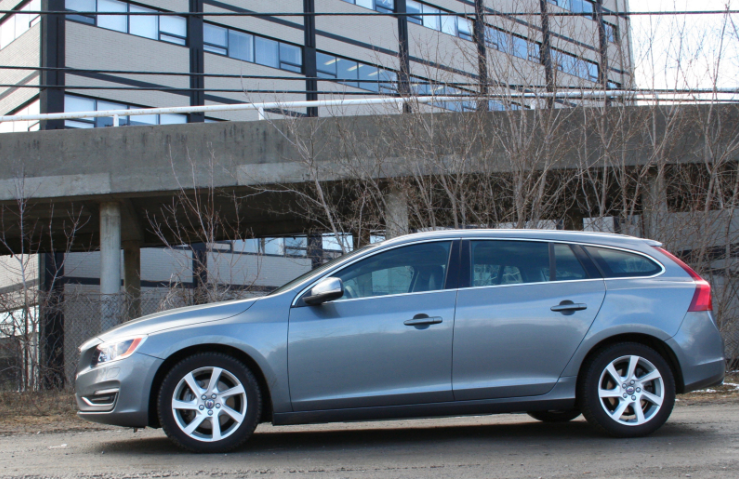Long-Term Test: 2016 Volvo V60 Sportwagon – The Verdict
Story and photo by John LeBlanc
Questions? Oh yes. We had quite a number when we gladly grabbed the key fob of our latest 60-day test drive subject, a 2016 Volvo V60 Sportwagon T6 Drive-E AWD Premier: Could a turbocharged and supercharged four-banger deliver the feel of similarly powerful engines with more cylinders? Can a station wagon really be a worthy people-and-their-stuff hauler in the age of the SUV and crossover? Would the Volvo’s generous amount of state-of-the-art safety tech overwhelm the compact wagon’s driving experience?
To answer all of the above, we spent two months taking advantage of the five-passenger, four-door Volvo wagon’s “Sport” prefix by driving it like the European luxury sports sedan its $55,000-plus as-tested price suggested. And just because it didn’t wear an “XC” badge, we didn’t let the Volvo off the hook when it came to family hauling duties.

If you’ve been following Volvo lately — especially its latest XC90, S90 and V90 models — the once-moribund automaker certainly has its distinctive Swedish design mojo back. And although the V60 Sportwagon is now six years old, we’ve found that its highly functional and well-appointed cabin only matched its attractive exterior styling.
Even towards the end of our tenure, spending time behind the wheel in the Volvo wagon was something we always looked forward to. As expected, the V60 Sportwagon’s seats were both orthopedically supportive and comfortable. Volvo has also upped the feel-good factor inside the car. The leather-class steering wheel felt rich to the touch (and warm during cold mornings, as it’s heated, too). And the various soft-brush aluminum bits were fitted well together with a host of soft plastics.
Matching the Volvo’s stress-relieving interior was our tester’s relaxed driving demeanour. As the middle child in the V60 Sportwagon family, our 302-horsepower T6 Drive-E AWD Premier sat between the base 240-horsepower, front-wheel-drive $40,600 T5 Drive-E and the high-performance 345-horsepower $67,295 Polestar.
As such, our tester delivered a comfort-first ride quality. The Volvo’s steering is quick, yet it lacked the feel of Teutonic rivals like the $43,200 Audi A4 Allroad Quattro and $47,850 BMW 3 Series xDrive Touring. On the plus side, the Volvo’s turbo- and supercharged 2.0-litre four-cylinder responded quickly, and its eight-speed automatic transmission was quite reactive, delivering a respectable 6.5-second zero to 100 km/h time.
Despite its sports sedan performance, after over 1,700 kilometres of mainly urban driving, our Volvo wagon was relatively parsimonious at the pumps. We saw an indicated fuel economy average of 9.9 L/100 km, about 20 percent better than what we’d expect from a comparable SUV or crossover.
One reason why the V60 Sportwagon guzzled as little as it did was due to Volvo’s new Drive-E system. Beyond the downsized-but-forced-air four-cylinder engine and eight-speed auto, Drive-E employs what Volvos calls its ECO+ technology.
Accessed via a centre dash button, ECO+ adjusts throttle response and gearbox shift points. The system also disengages the transmission clutch to coast when the driver lifts off the gas pedal, backs off on the air-conditioning to ease engine load and employs a stop/start system to shut down the engine when the vehicle isn’t moving — all in the interest of saving fuel.
One beef with our Volvo was the lack of refinement in the ECO+ system’s stop/start engagement. First, the system stops the engine at the earliest opportunity, even when coasting to a stop. Then the restart causes the car to judder. In any kind of stop-and-start traffic, we simply turned the stop/start off, fuel economy be damned.
As we discovered during a family ski holiday, the Volvo’s rear cargo space wasn’t overly impressive. It’s the price you pay for the V60 Sportwagon’s non-Volvo (i.e. non-boxy) rear styling. The Audi and BMW wagons offer more overall space, but we did find that the Volvo’s 40/20/40 split rear seat (instead of the usual 40/60 setup) and front passenger seat, which can also fold flat, made for a flexible if not cavernous hauler.
Our other discovery was the V60 Sportwagon’s inherent value. While $55,000-plus may seem pricey for a compact wagon, a BMW 3 Series Touring equipped like our tester would cost you about $7,000 more.
So what did we learn after 60 days with the Volvo?
Overall, the non-conforming 2016 Volvo V60 Sportwagon T6 Drive-E AWD Premier delivered a stress-free driving experience. Its well-thought-out interior and loads of safety tech made it a fantastic family-touring machine. Yet it could still act as a sports sedan when keen drivers wanted to go for a spin.
And even if our specific V60 Sportwagon doesn’t tickle your fancy, it’s good to know that Volvo is committed to the wagon buyer, offering a wider range of powertrains and models than its German competition. After eight weeks in our unconventional Volvo wagon, we are convinced you will find one to your liking. And you’ll like it enough to ditch your all-too-common SUV.





![[del.icio.us]](https://www.straight-six.com/wp-content/plugins/bookmarkify/delicious.png)
![[Digg]](https://www.straight-six.com/wp-content/plugins/bookmarkify/digg.png)
![[Facebook]](https://www.straight-six.com/wp-content/plugins/bookmarkify/facebook.png)
![[Google]](https://www.straight-six.com/wp-content/plugins/bookmarkify/google.png)
![[Reddit]](https://www.straight-six.com/wp-content/plugins/bookmarkify/reddit.png)
![[StumbleUpon]](https://www.straight-six.com/wp-content/plugins/bookmarkify/stumbleupon.png)
![[Twitter]](https://www.straight-six.com/wp-content/plugins/bookmarkify/twitter.png)
![[Email]](https://www.straight-six.com/wp-content/plugins/bookmarkify/email.png)